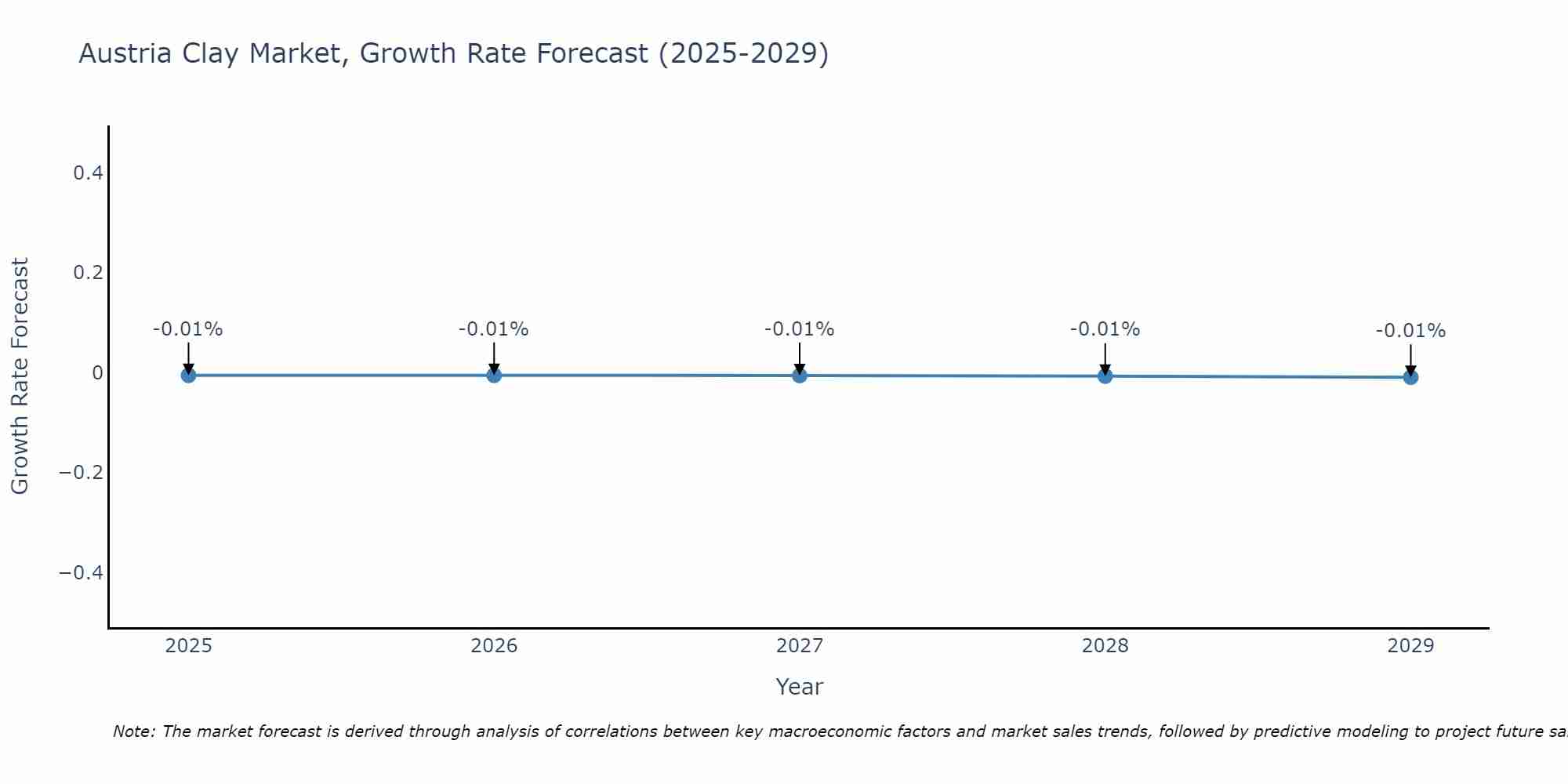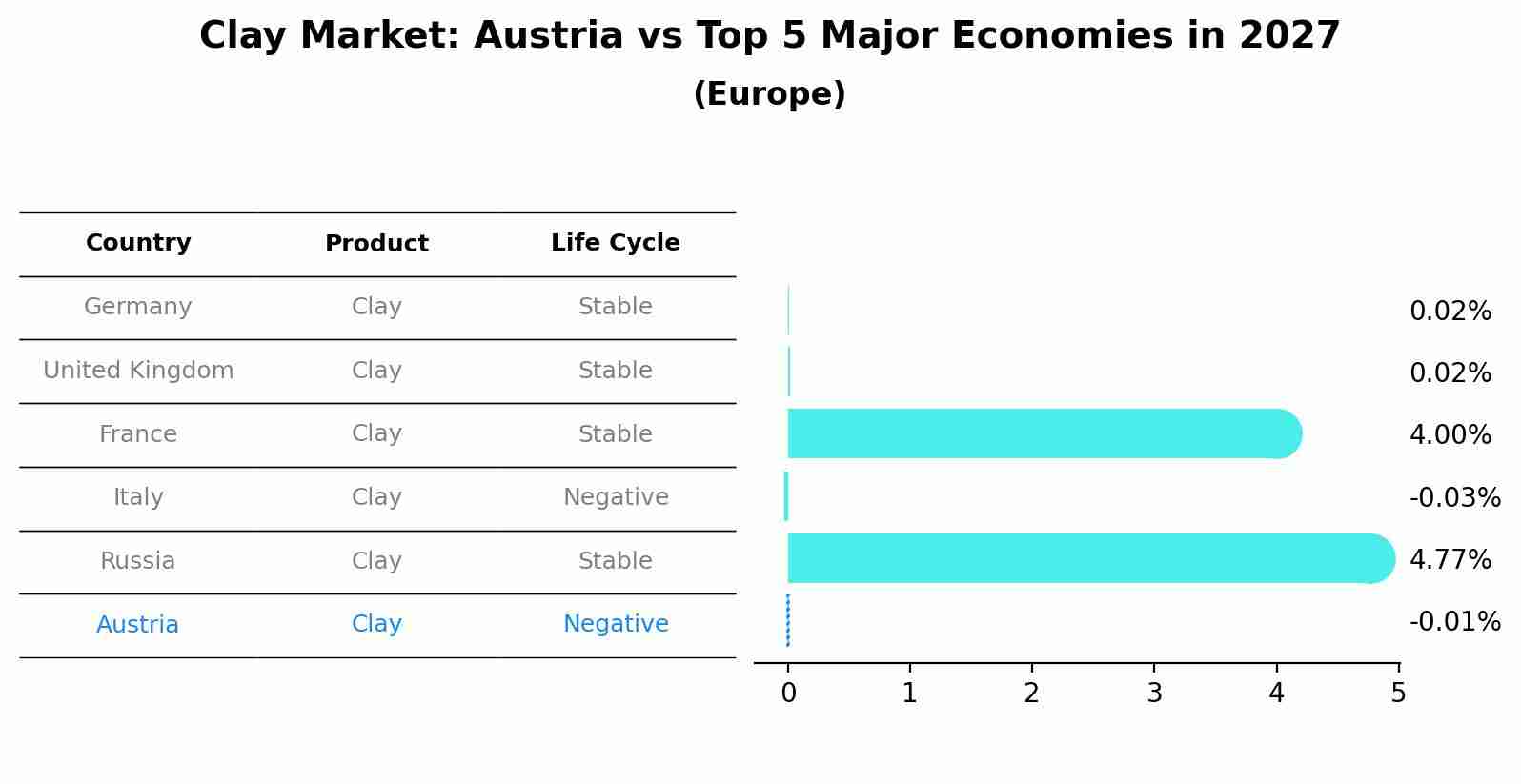Austria Clay Market (2025-2031) | Share, Segmentation, Forecast, Revenue, Analysis, Value, Companies, Trends, Growth, Outlook, Industry & Size
| Product Code: ETC5257622 | Publication Date: Nov 2023 | Updated Date: Sep 2025 | Product Type: Market Research Report | |
| Publisher: 6Wresearch | No. of Pages: 60 | No. of Figures: 30 | No. of Tables: 5 | |
Austria Clay Market Size Growth Rate
The Austria Clay Market is projected to witness mixed growth rate patterns during 2025 to 2029. Starting at -0.01% in 2025, the market peaks at -0.01% in 2026, and settles at -0.01% by 2029.

Clay Market: Austria vs Top 5 Major Economies in 2027 (Europe)
The Clay market in Austria is projected to grow at a negative growth rate of -0.01% by 2027, highlighting the country's increasing focus on advanced technologies within the Europe region, where Germany holds the dominant position, followed closely by United Kingdom, France, Italy and Russia, shaping overall regional demand.

Austria Clay Market Overview
The clay market in Austria offers natural mineral deposits used in ceramics, construction materials, and industrial applications requiring clay minerals` plasticity and binding properties. Clay products include kaolin, bentonite, and ball clay variants offering thermal insulation, water absorption, and chemical stability in pottery, refractories, and drilling muds. Key applications include ceramic tile production, foundry casting, and pharmaceutical formulations. Key trends include the adoption of sustainable clay mining practices, the development of nanostructured clay composites for advanced materials, and the customization of clay blends for specialized industrial processes.
Drivers of the market
Austria`s clay market is influenced by its use in ceramics, construction, and industrial applications. The demand for high-quality clay for manufacturing tiles, bricks, and pottery drives this market.
Challenges of the market
The clay market in Austria faces challenges related to the fluctuating prices and availability of raw materials, such as kaolin and bentonite, which are influenced by global supply and demand dynamics. Ensuring the consistent quality, performance, and safety of clay for various applications, such as ceramics, construction, and paper manufacturing, adds complexity to the market. Additionally, competition from alternative clay sources and the rapid pace of technological advancements impact market demand. Regulatory compliance with safety and environmental standards also poses challenges. Manufacturers must invest in sustainable sourcing practices, quality control systems, and research and development to maintain market competitiveness and meet industrial demands for high-quality clay.
Government Policy of the market
The Austrian government promotes the clay market through policies that support the construction and ceramics industries. Financial incentives and grants are available for companies producing high-quality clay used in building materials and pottery. The government invests in research to improve the properties and applications of clay, fostering innovation and supporting sustainable construction practices.
Key Highlights of the Report:
- Austria Clay Market Outlook
- Market Size of Austria Clay Market, 2024
- Forecast of Austria Clay Market, 2031
- Historical Data and Forecast of Austria Clay Revenues & Volume for the Period 2021-2031
- Austria Clay Market Trend Evolution
- Austria Clay Market Drivers and Challenges
- Austria Clay Price Trends
- Austria Clay Porter`s Five Forces
- Austria Clay Industry Life Cycle
- Historical Data and Forecast of Austria Clay Market Revenues & Volume By Application for the Period 2021-2031
- Historical Data and Forecast of Austria Clay Market Revenues & Volume By Tableware for the Period 2021-2031
- Historical Data and Forecast of Austria Clay Market Revenues & Volume By Sanitary ware for the Period 2021-2031
- Historical Data and Forecast of Austria Clay Market Revenues & Volume By Medical applications for the Period 2021-2031
- Historical Data and Forecast of Austria Clay Market Revenues & Volume By End Use for the Period 2021-2031
- Historical Data and Forecast of Austria Clay Market Revenues & Volume By Ceramic and for the Period 2021-2031
- Historical Data and Forecast of Austria Clay Market Revenues & Volume By Non-ceramic for the Period 2021-2031
- Austria Clay Import Export Trade Statistics
- Market Opportunity Assessment By Application
- Market Opportunity Assessment By End Use
- Austria Clay Top Companies Market Share
- Austria Clay Competitive Benchmarking By Technical and Operational Parameters
- Austria Clay Company Profiles
- Austria Clay Key Strategic Recommendations
Frequently Asked Questions About the Market Study (FAQs):
1 Executive Summary |
2 Introduction |
2.1 Key Highlights of the Report |
2.2 Report Description |
2.3 Market Scope & Segmentation |
2.4 Research Methodology |
2.5 Assumptions |
3 Austria Clay Market Overview |
3.1 Austria Country Macro Economic Indicators |
3.2 Austria Clay Market Revenues & Volume, 2021 & 2031F |
3.3 Austria Clay Market - Industry Life Cycle |
3.4 Austria Clay Market - Porter's Five Forces |
3.5 Austria Clay Market Revenues & Volume Share, By Application, 2021 & 2031F |
3.6 Austria Clay Market Revenues & Volume Share, By End Use, 2021 & 2031F |
4 Austria Clay Market Dynamics |
4.1 Impact Analysis |
4.2 Market Drivers |
4.2.1 Growing demand for clay in construction and infrastructure projects in Austria |
4.2.2 Increasing use of clay in the manufacturing of ceramics, tiles, and bricks |
4.2.3 Rising awareness about the sustainable and eco-friendly properties of clay products |
4.3 Market Restraints |
4.3.1 Fluctuating raw material prices impacting the production cost of clay products |
4.3.2 Competition from alternative materials such as concrete and plastic |
4.3.3 Regulatory challenges related to environmental standards and mining practices |
5 Austria Clay Market Trends |
6 Austria Clay Market Segmentations |
6.1 Austria Clay Market, By Application |
6.1.1 Overview and Analysis |
6.1.2 Austria Clay Market Revenues & Volume, By Tableware, 2021-2031F |
6.1.3 Austria Clay Market Revenues & Volume, By Sanitary ware, 2021-2031F |
6.1.4 Austria Clay Market Revenues & Volume, By Medical applications, 2021-2031F |
6.2 Austria Clay Market, By End Use |
6.2.1 Overview and Analysis |
6.2.2 Austria Clay Market Revenues & Volume, By Ceramic and, 2021-2031F |
6.2.3 Austria Clay Market Revenues & Volume, By Non-ceramic, 2021-2031F |
7 Austria Clay Market Import-Export Trade Statistics |
7.1 Austria Clay Market Export to Major Countries |
7.2 Austria Clay Market Imports from Major Countries |
8 Austria Clay Market Key Performance Indicators |
8.1 Average selling price of clay products in Austria |
8.2 Number of new construction projects using clay as a primary material |
8.3 Percentage of manufacturers using sustainable practices in clay production |
9 Austria Clay Market - Opportunity Assessment |
9.1 Austria Clay Market Opportunity Assessment, By Application, 2021 & 2031F |
9.2 Austria Clay Market Opportunity Assessment, By End Use, 2021 & 2031F |
10 Austria Clay Market - Competitive Landscape |
10.1 Austria Clay Market Revenue Share, By Companies, 2024 |
10.2 Austria Clay Market Competitive Benchmarking, By Operating and Technical Parameters |
11 Company Profiles |
12 Recommendations | 13 Disclaimer |
- Single User License$ 1,995
- Department License$ 2,400
- Site License$ 3,120
- Global License$ 3,795
Search
Related Reports
- ASEAN and Thailand Brain Health Supplements Market (2025-2031) | Strategy, Consumer Insights, Analysis, Investment Trends, Opportunities, Growth, Size, Share, Industry, Revenue, Segments, Value, Segmentation, Supply, Forecast, Restraints, Outlook, Competition, Drivers, Trends, Demand, Pricing Analysis, Competitive, Strategic Insights, Companies, Challenges
- ASEAN Bearings Market (2025-2031) | Strategy, Consumer Insights, Analysis, Investment Trends, Opportunities, Growth, Size, Share, Industry, Revenue, Segments, Value, Segmentation, Supply, Forecast, Restraints, Outlook, Competition, Drivers, Trends, Demand, Pricing Analysis, Competitive, Strategic Insights, Companies, Challenges
- Europe Flooring Market (2025-2031) | Outlook, Share, Industry, Trends, Forecast, Companies, Revenue, Size, Analysis, Growth & Value
- Saudi Arabia Manlift Market (2025-2031) | Outlook, Size, Growth, Trends, Companies, Industry, Revenue, Value, Share, Forecast & Analysis
- Uganda Excavator, Crane, and Wheel Loaders Market (2025-2031) | Strategy, Consumer Insights, Analysis, Investment Trends, Opportunities, Growth, Size, Share, Industry, Revenue, Segments, Value, Segmentation, Supply, Forecast, Restraints, Outlook, Competition, Drivers, Trends, Demand, Pricing Analysis, Competitive, Strategic Insights, Companies, Challenges
- Rwanda Excavator, Crane, and Wheel Loaders Market (2025-2031) | Strategy, Consumer Insights, Analysis, Investment Trends, Opportunities, Growth, Size, Share, Industry, Revenue, Segments, Value, Segmentation, Supply, Forecast, Restraints, Outlook, Competition, Drivers, Trends, Demand, Pricing Analysis, Competitive, Strategic Insights, Companies, Challenges
- Kenya Excavator, Crane, and Wheel Loaders Market (2025-2031) | Strategy, Consumer Insights, Analysis, Investment Trends, Opportunities, Growth, Size, Share, Industry, Revenue, Segments, Value, Segmentation, Supply, Forecast, Restraints, Outlook, Competition, Drivers, Trends, Demand, Pricing Analysis, Competitive, Strategic Insights, Companies, Challenges
- Angola Excavator, Crane, and Wheel Loaders Market (2025-2031) | Strategy, Consumer Insights, Analysis, Investment Trends, Opportunities, Growth, Size, Share, Industry, Revenue, Segments, Value, Segmentation, Supply, Forecast, Restraints, Outlook, Competition, Drivers, Trends, Demand, Pricing Analysis, Competitive, Strategic Insights, Companies, Challenges
- Israel Intelligent Transport System Market (2025-2031) | Strategy, Consumer Insights, Analysis, Investment Trends, Opportunities, Growth, Size, Share, Industry, Revenue, Segments, Value, Segmentation, Supply, Forecast, Restraints, Outlook, Competition, Drivers, Trends, Demand, Pricing Analysis, Competitive, Strategic Insights, Companies, Challenges
- Uganda Precast and Aggregate Market (2025-2031) | Strategy, Consumer Insights, Analysis, Investment Trends, Opportunities, Growth, Size, Share, Industry, Revenue, Segments, Value, Segmentation, Supply, Forecast, Restraints, Outlook, Competition, Drivers, Trends, Demand, Pricing Analysis, Competitive, Strategic Insights, Companies, Challenges
Industry Events and Analyst Meet
Our Clients
Whitepaper
- Middle East & Africa Commercial Security Market Click here to view more.
- Middle East & Africa Fire Safety Systems & Equipment Market Click here to view more.
- GCC Drone Market Click here to view more.
- Middle East Lighting Fixture Market Click here to view more.
- GCC Physical & Perimeter Security Market Click here to view more.
6WResearch In News
- Doha a strategic location for EV manufacturing hub: IPA Qatar
- Demand for luxury TVs surging in the GCC, says Samsung
- Empowering Growth: The Thriving Journey of Bangladesh’s Cable Industry
- Demand for luxury TVs surging in the GCC, says Samsung
- Video call with a traditional healer? Once unthinkable, it’s now common in South Africa
- Intelligent Buildings To Smooth GCC’s Path To Net Zero













